The 10 Biggest Sharks in Washington State (And Puget Sound) (original) (raw)
If you’re planning on taking a swim in the waters of Puget Sound, have no fear. Yes, there are sharks in the Sound, but there has never been a shark attack in the peaceful waters of the Salish Sea. In fact, there have only been two recorded shark attacks (nonfatal) in Washington State waters, and both occurred in Gray’s Harbor on the West Coast. Globally, just about every species of shark out there is at risk of extinction. So, let’s learn about the biggest sharks in Washington State and how we can conserve them for future generations!
10. Spiny Dogfish
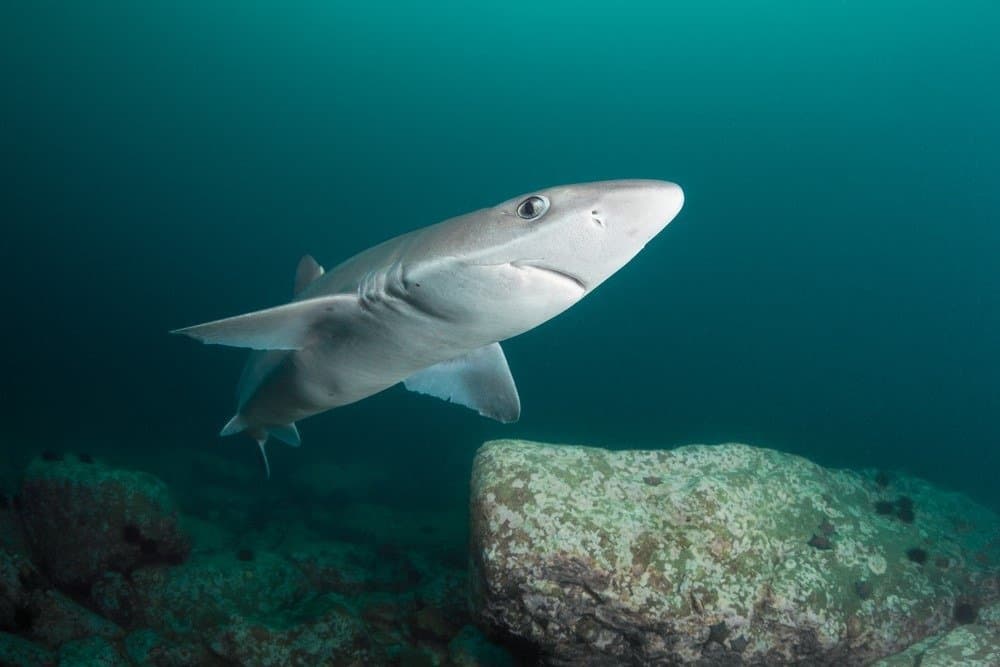
In scientific terms, the
spiny dogfish
is known as
Squalus acanthias
. They live in shallow coastal waters in many parts of the world.
©Boris Pamikov/Shutterstock.com
The spiny dogfish might not be the biggest shark in Washington State, but they’re no small fries. These sharks grow up to five feet long and have light gray, slender bodies. Spiny dogfish are thought to live 70 years or more and typically live between 150-500 feet beneath the ocean’s surface. They’re critically endangered in the North Atlantic and classified as Vulnerable everywhere else. But don’t worry. You won’t be receiving a bite from a spiny dogfish anytime soon. They don’t attack people.
9. Pacific Angel Shark
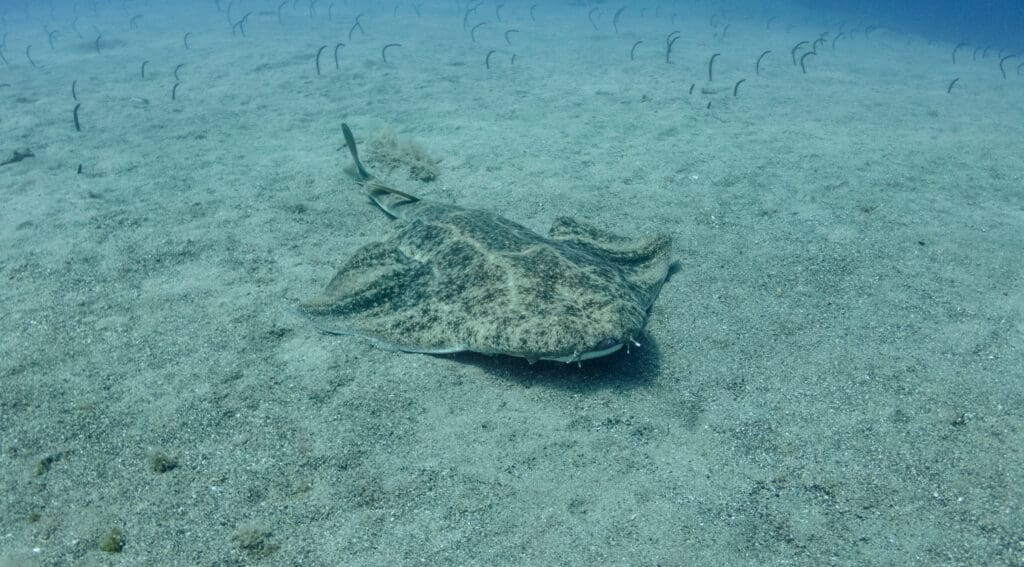
Squatina californica
Despite its scientific name, the Pacific
angel shark
actually inhabits the western coasts of most of North and South America.
©LuisMiguelEstevez/Shutterstock.com
Pacific angel sharks grow up to seven feet long, though they don’t look like your typical shark. These sharks look closer to stingrays; they have flattened, sand-colored bodies, wide heads, and large pectoral fins with long, thin tails. They’re listed as Near Threatened and spend most of their time hanging out on the seafloor waiting for prey.
8. Broadnose Sevengill Shark
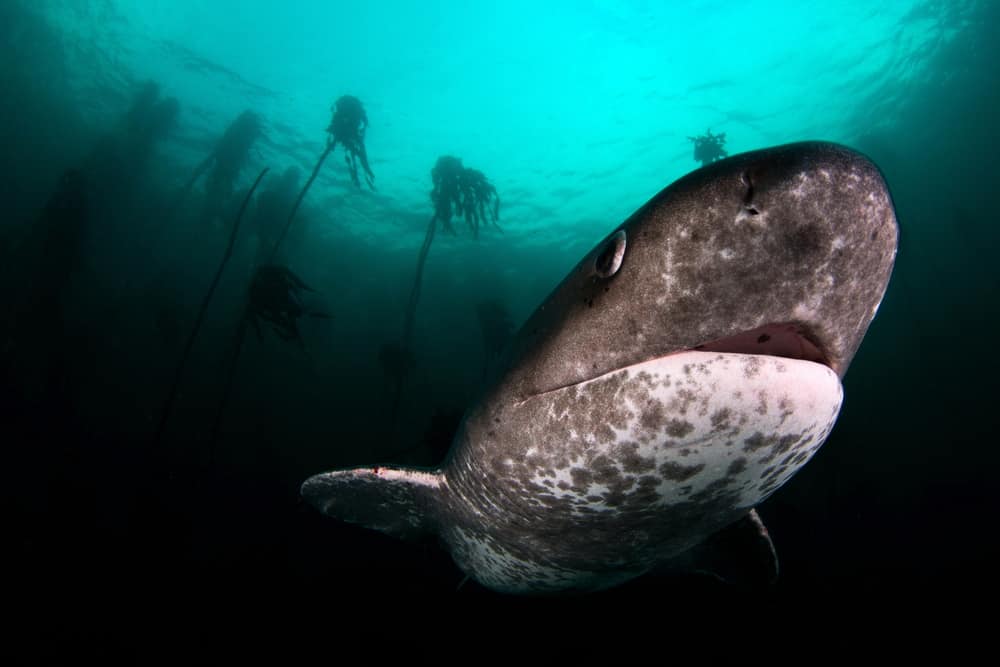
Notorynchus cepedianus
, the broadnose sevengill shark, gets its name from its seven pairs of gills.
©Tomas Kotouc/Shutterstock.com
Where most sharks have five gills on either side of their head, the sevengill shark has seven. As some of the biggest sharks in Washington State, these sharks grow up to ten feet long. They’re not found in the Puget Sound, but they are occasionally caught by fishermen off the coast of Washington State in deep ocean waters. Sevengill sharks eat other sharks, fish, porpoises, dolphins, seals, rays, and even carrion. They travel to Willapa Bay and Grays Harbor on Washington’s west coast to have their pups.
7. Salmon Shark
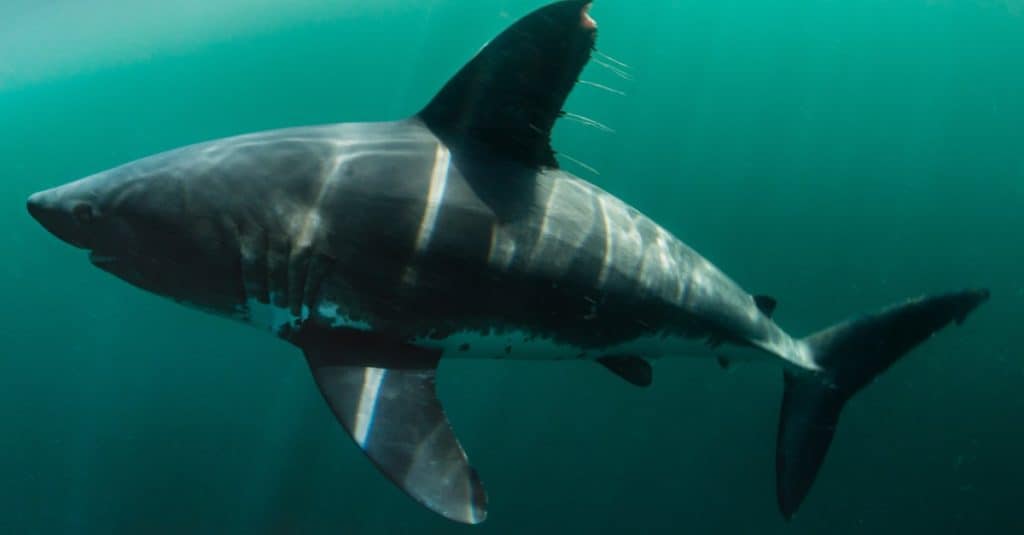
Lamna ditropis,
the
salmon shark
, are occasionally seen by fishermen off Washington’s west coast.
©Warren Metcalf/Shutterstock.com
Salmon sharks are some of the biggest sharks in Washington State. They’re often mistaken for Great Whites; both are mackerel sharks. However, salmon sharks only grow to a maximum length of ten feet and don’t attack people. They eat salmon, spiny dogfish, squid, and any other fish they come across. Salmon sharks live in the coastal waters of Washington State, not in Puget Sound.
6. Blue Shark
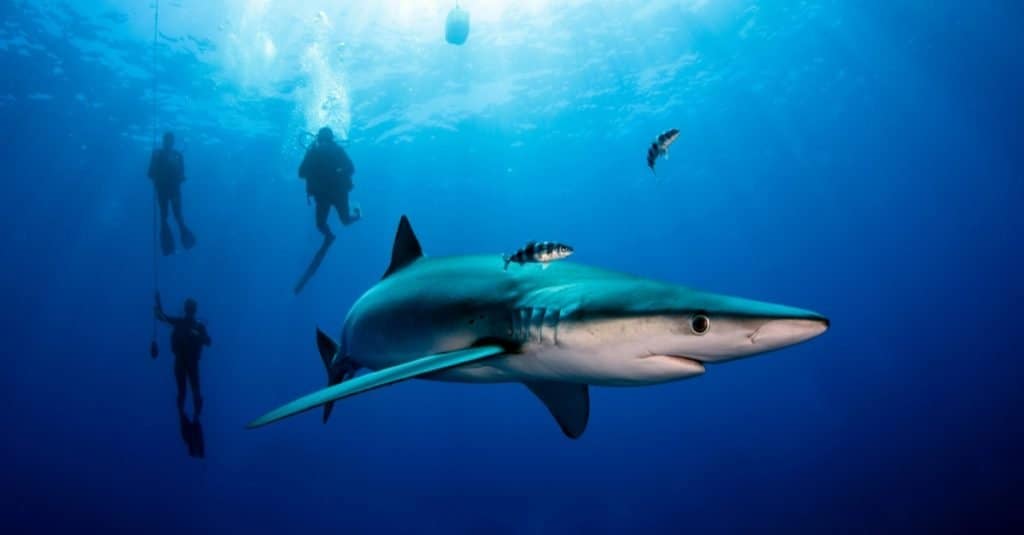
The
blue shark
, otherwise known as
Prionace glauca
, lives off the coast of western Washington State in open ocean waters.
©Vladislav Klimin/Shutterstock.com
Blue sharks grow up to 13 feet long and can have up to 135 pups at a time. They have long, slender bodies, which make them very fast swimmers. They’re found in the oceanic waters off the west coast of Washington State and almost never in Puget Sound. Blue sharks eat squid and fish, crab, shrimp, and octopus. They’re almost entirely nocturnal.
5. Pacific Sleeper Shark
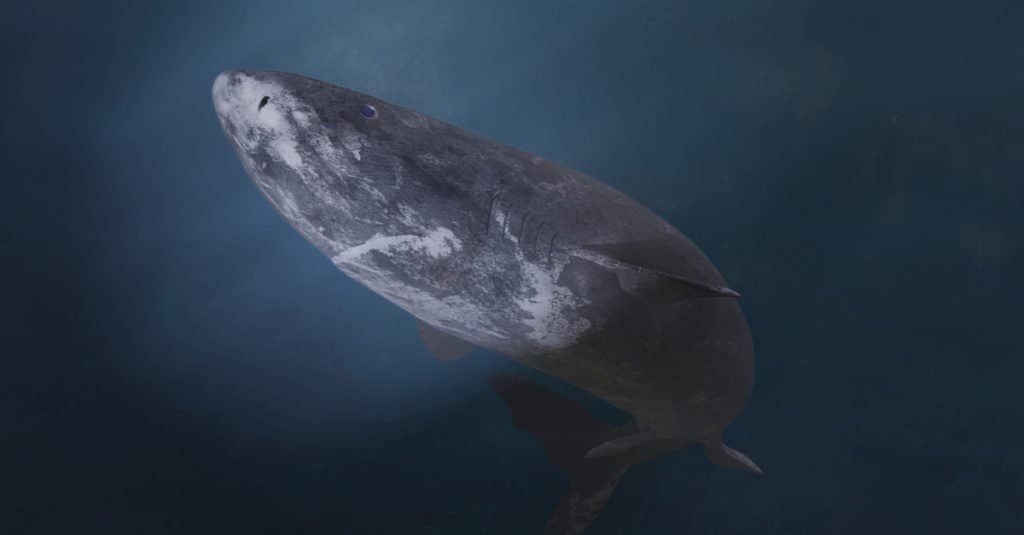
Somniosus pacificus,
the Pacific
sleeper shark
, lives deep below the ocean’s surface and is rarely seen by humans.
©iStock.com/dottedhippo
The Puget Sound is home to one of the biggest sharks in Washington State; the Pacific sleeper shark. They grow up to 14 feet long, though some scientists believe they reach even greater lengths. Pacific sleeper sharks eat fish, shrimp, crab, squid, salmon, and occasionally porpoises or sea lions. They live both in Puget Sound and off the coast of Washington State and are often preyed upon by orca whales.
4. Great White
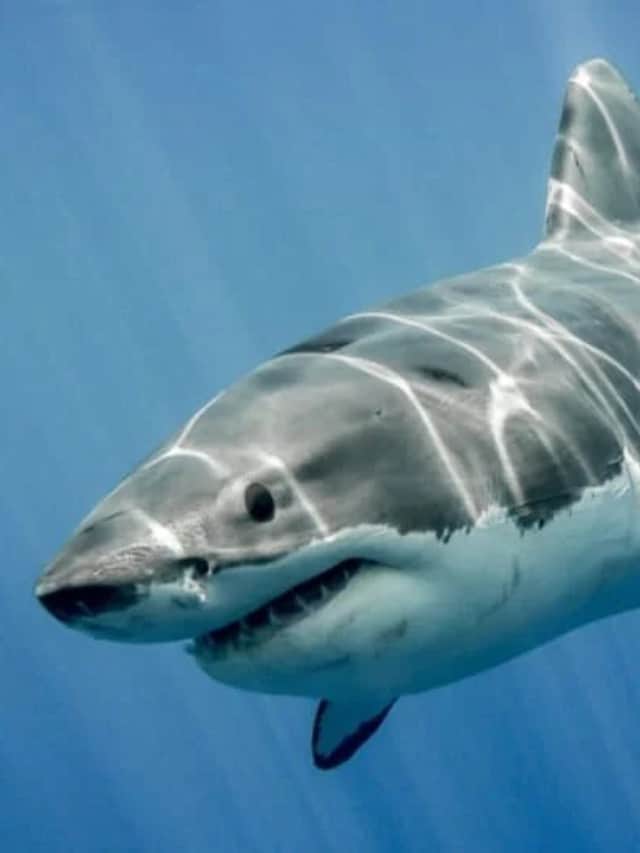
Carcharodon carcharias, the great white shark, makes only the occasional appearance in Washington State waters.
Great white sharks, some of the most impressive apex predators alive today, are some of the biggest sharks in Washington State. They grow up to 16 feet long (with the largest great white reaching more than 20 feet) and eat seals, dolphins, bony fish, and porpoises. Additionally, they’re not found in Puget Sound, but they do occasionally approach the coastal waters of western Washington. The only two recorded shark attacks in Washington State are attributed to great white sharks. Both attacks occurred in Gray’s Harbor, in the southwest part of the state.
3. Common Thresher
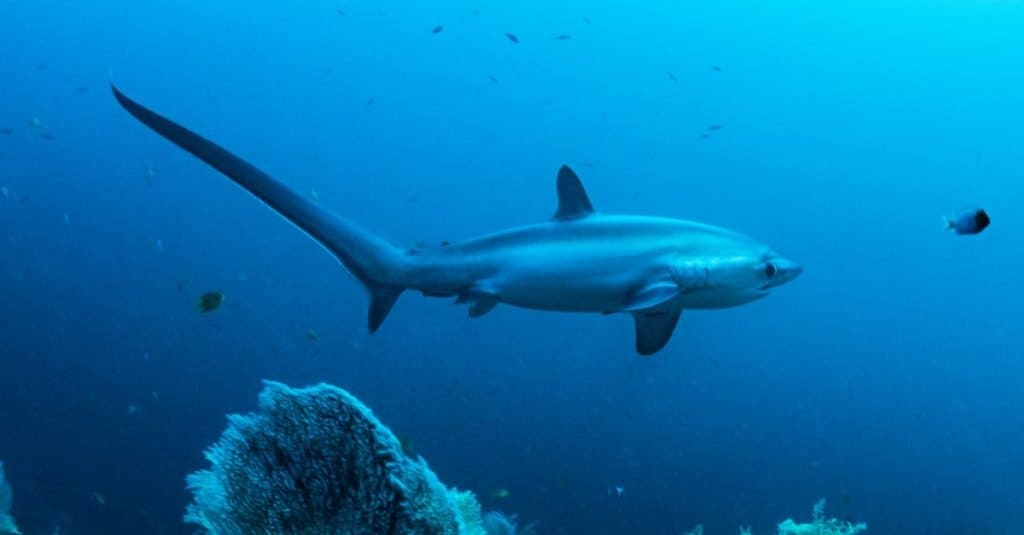
Alopias vulpinus
, the common thresher, inhabits the coastal waters of western Washington State.
©Shane Gross/Shutterstock.com
Common thresher sharks grow up to 20 feet long, with slender bodies that can weigh up to 1,000 pounds. They have extremely long tails that can make up almost half their overall length. These sharks aren’t found in Puget Sound, but they are occasionally encountered by fishermen off the west coast. Common threshers are currently listed as Vulnerable, as are many of the world’s sharks. They’re aggressive hunters and eat fish of all varieties.
2. Bluntnose Sixgill Shark
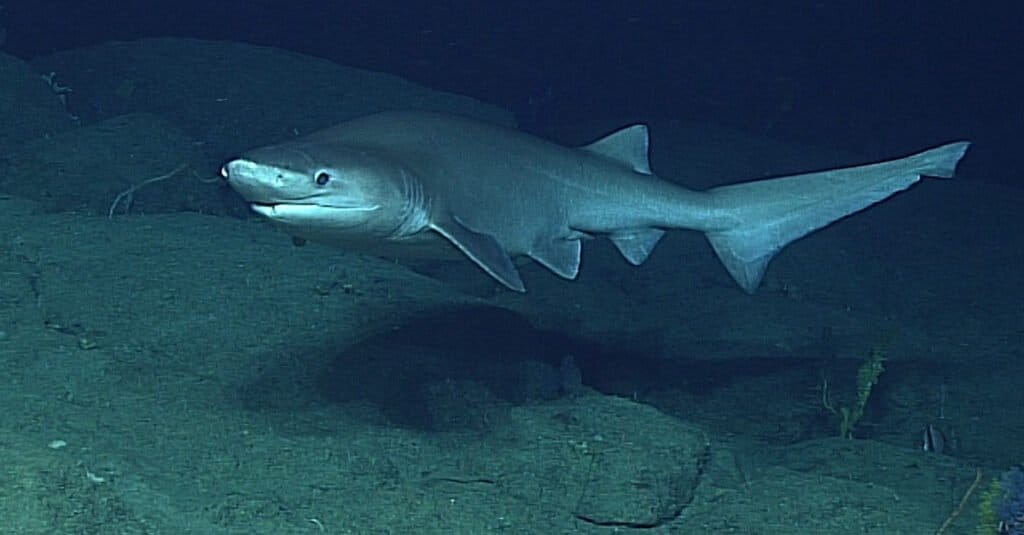
The bluntnose
sixgill shark
(Hexanchus griseus) is also known as a cow shark.
©NOAA Ocean Explorer from USA / CC BY-SA 2.0, via Wikimedia Commons – Original / License
Bluntnose sixgill sharks are some of the biggest sharks in Washington State. They can reach 20 feet long and usually live between 6,000 and 300 feet deep. Juveniles are fairly common in Puget Sound, though they don’t attack humans. Adults longer than ten feet live off the coast of Washington State. They eat fish, crab, shrimp, seals, and other sharks. Bluntnose sixgill sharks are only rarely seen by humans.
1. Basking Shark
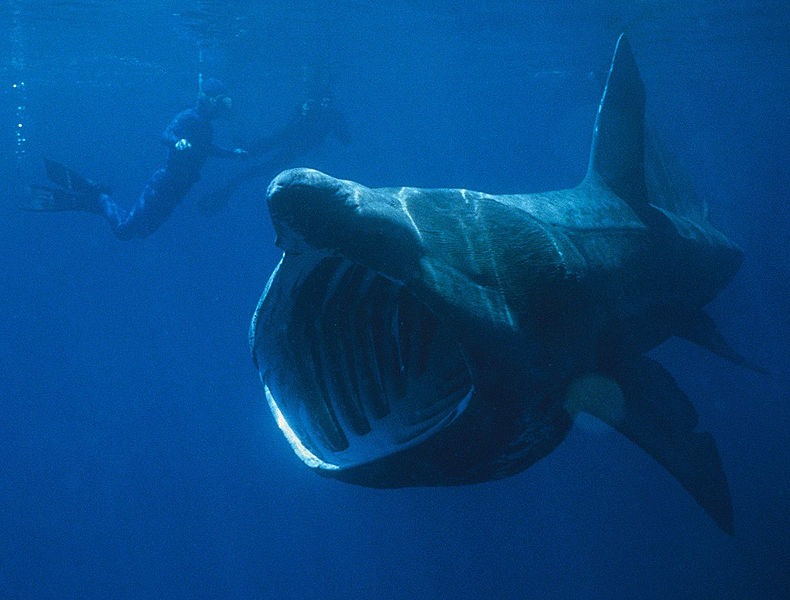
Cetorhinus maximus, the
basking shark
, is the second-largest extant shark. Only the
whale shark
tops it in size.
©Chris Gotschalk / Public Domain, from Wikimedia Commons, the free media repository – Original / License
Basking sharks are the biggest sharks in Washington State. They’re not found in Puget Sound, but they do visit the waters of coastal Washington. These sharks grow up to 45 feet long. But don’t worry—they don’t attack people. Despite their huge size, basking sharks are filter feeders who eat zooplankton and tiny fish. Additionally, they’re currently in danger of extinction due to overfishing, pollution, and culling for shark fin soup.
Honorable Mention: Other Large Sharks in Washington State
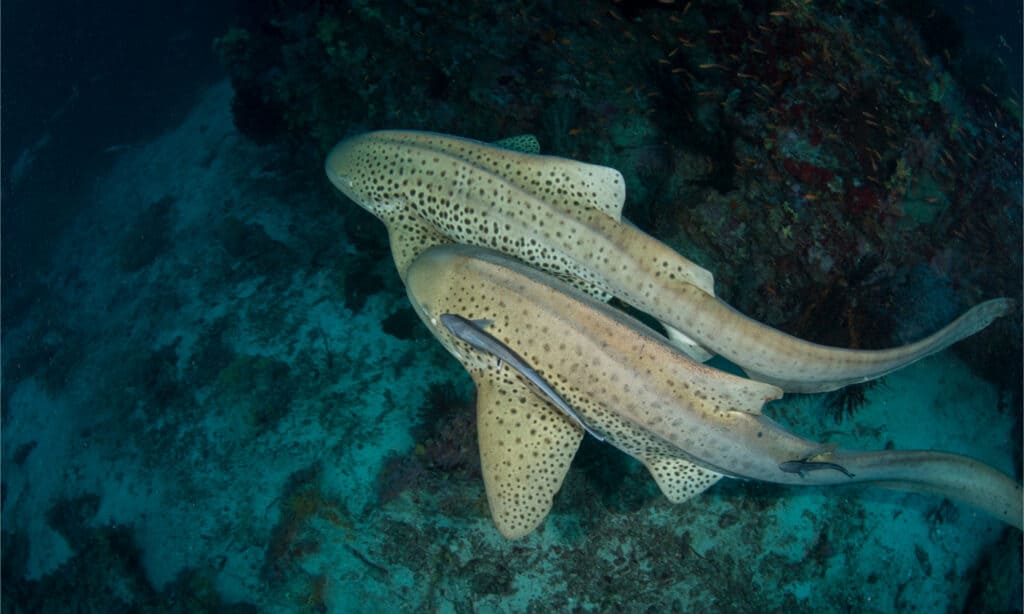
Leopard
Sharks are one of the least aggressive sharks and are typically timid but won’t bother you.
©John Back/Shutterstock.com
The waters off the coast of Washington State are said to be home to around 30 different species of sharks. They all vary in size, shape, and severity of their aggression, from one of the larger and more aggressive species on the list, the always-popular great white shark, to the completely harmless basking shark, taking the number one spot. There are many other beautiful, and sizable, creatures roaming the waters that deserve to be mentioned. Here are just a few:
- Leopard Shark (Triakis semifasciata) – one of the non-aggressive sharks found on our list, this beautifully colored shark, known for its patterns and markings, can grow up to almost five feet and typically does not pose a threat to humans. They are a species of bottom-feeding houndshark that are even safe to snorkel with in certain areas on the West Coast. However, it is important to remember they are wild animals and while you may be in the same vicinity, you should not touch them.
- Sand Tiger Shark (Odontaspididae) – another non-aggressive shark on our list and of no relation to the tiger shark, this species can grow up to 10.5 and is found on sandy shorelines throughout the world. Also known as the gray nurse shark, the sand shark, and the ragged tooth shark, this fish belongs to the family of mackerel sharks.
- Smooth Hammerhead Shark (Sphyrna zygaena) – this is the second-largest of the hammerhead species, which can grow to lengths of up to 16 feet. It can be distinguished from other hammerhead species because of its distinctively smooth-shaped head that is flattened, or rounded, and does not have the notches or indentations that are found on other species, like the scalloped hammerhead.
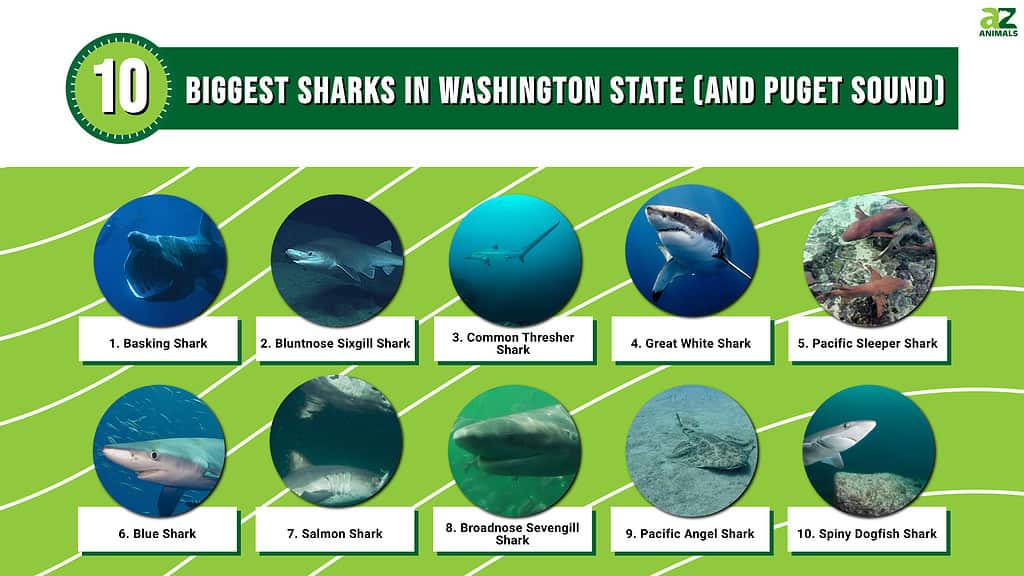
| Rank | Shark Name | Shark Length |
|---|---|---|
| 1 | Basking Shark | 45 feet |
| 2 | Bluntnose Sixgill Shark | 20 feet |
| 3 | Common Thresher Shark | 20 feet |
| 4 | Great White Shark | 16 feet |
| 5 | Pacific Sleeper Shark | 14 feet |
| 6 | Blue Shark | 13 feet |
| 7 | Salmon Shark | 10 feet |
| 8 | Broadnose Sevengill Shark | 10 feet |
| 9 | Pacific Angel Shark | 7 feet |
| 10 | Spiny Dogfish Shark | 5 feet |
Share this post on:
Brandi Allred
Brandi is a professional writer by day and a fiction writer by night. Her nonfiction work focuses on animals, nature, and conservation. She holds degrees in English and Anthropology, and spends her free time writing horror, scifi, and fantasy stories.
Thank you for reading! Have some feedback for us?
Thank you for your feedback!
We appreciate your help in improving our content.
Our editorial team will review your suggestions and make any necessary updates.
There was an error submitting your feedback. Please try again.